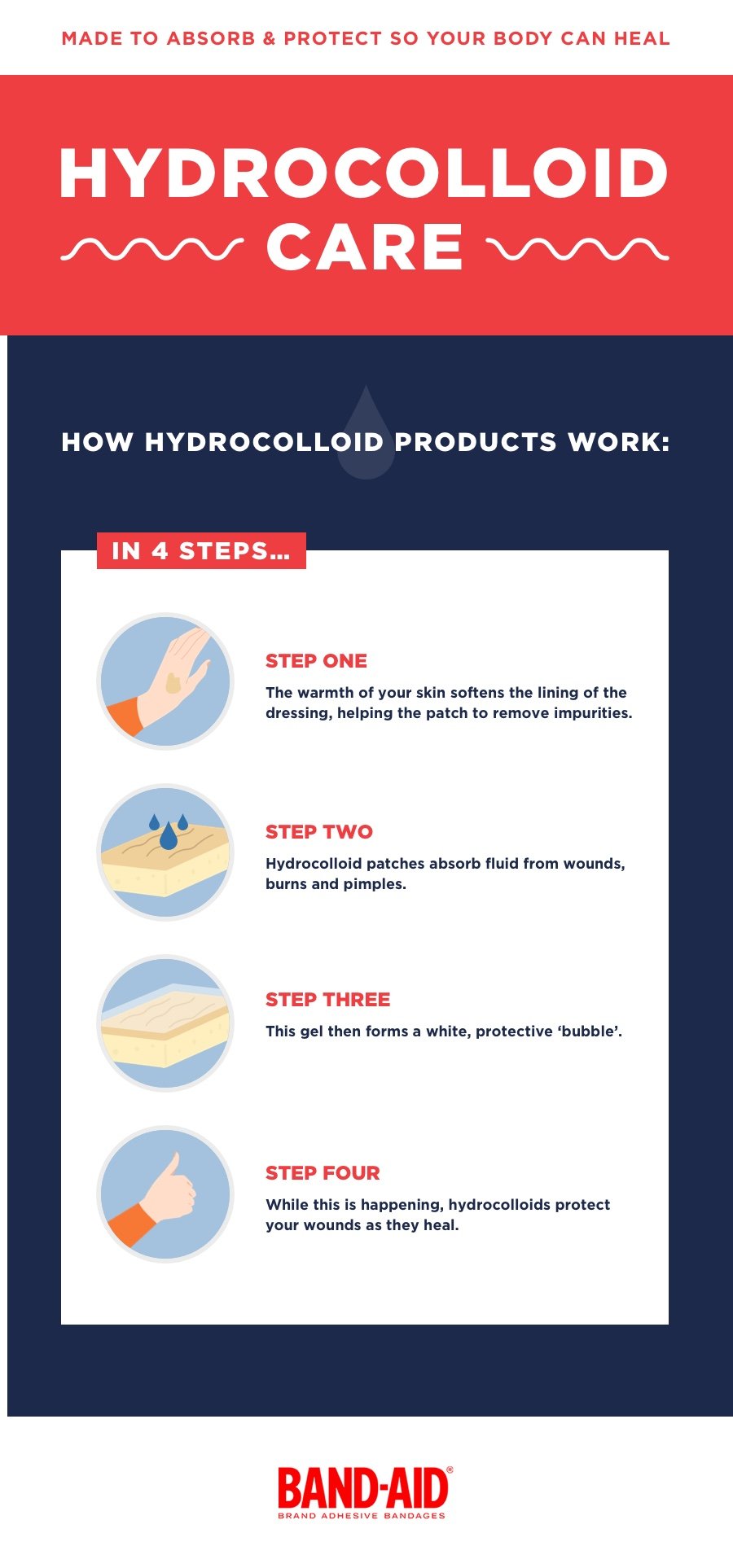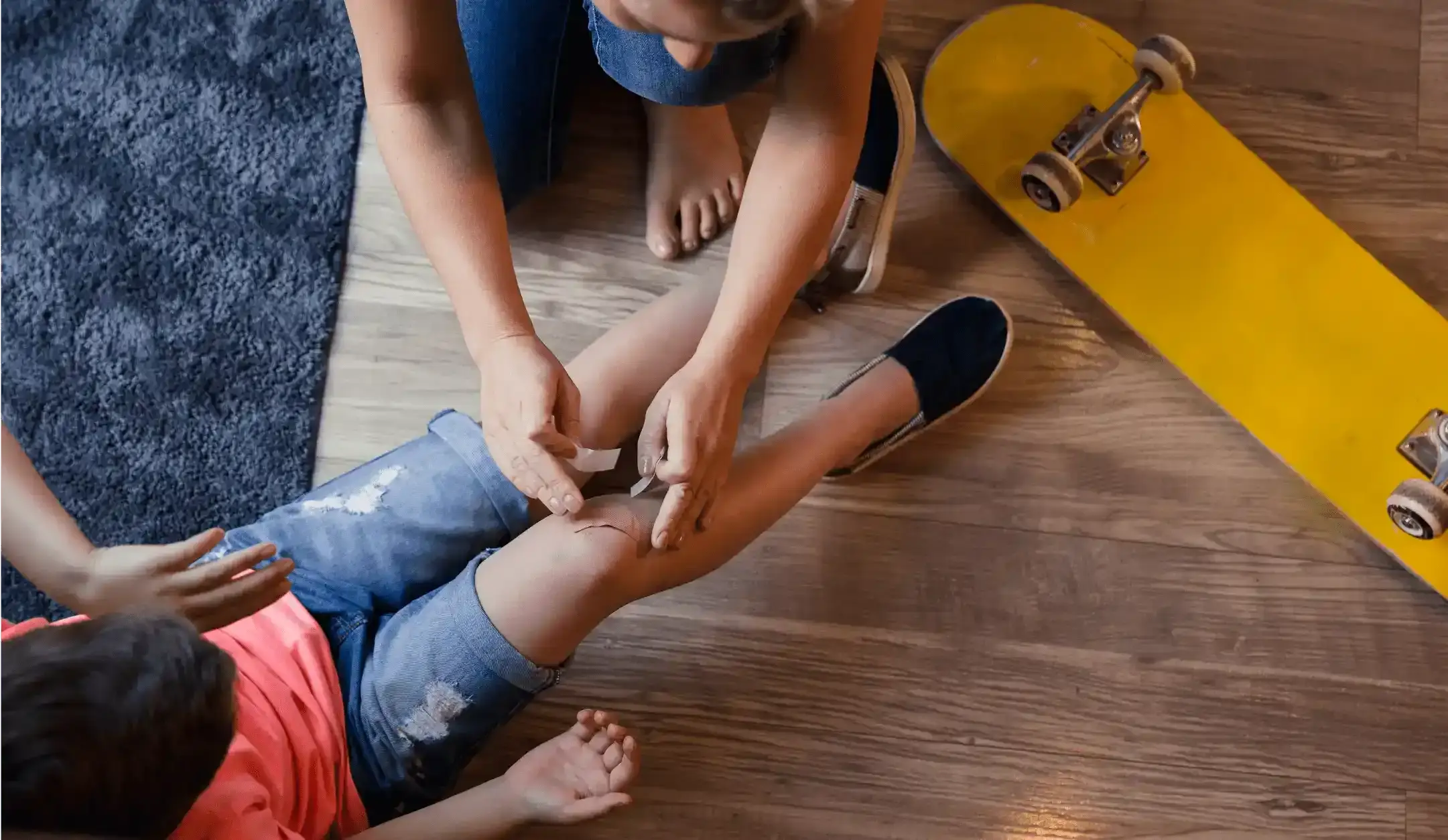What Is a Hydrocolloid?
Hydrocolloids are moisture-retentive dressings. This means that they keep hold of water to create an effective insulating environment to aid the wound-healing process2. By doing this, they help your body’s natural enzymes to do their job and heal your skin2.
Hydrocolloid bandages typically contain gel-forming agents such as sodium carboxymethyl cellulose and gelatin2. They may also contain pectin and hydrophobic pressure-sensitive polymers like polyisobutylene2.
How Do Hydrocolloid Patches Work?
Hydrocolloid patches come in different shapes and sizes to help tackle different types of wounds, from burns and scrapes to acne blemishes.
These products are designed to be more absorbent than other dressings, meaning they help absorb any discharge from uninfected wounds, without drying them out – but allowing them to heal2.
Whatever wound type you're using them for, simply apply the dressing to the wound, sticky-side down, and secure it in place. Most of the dressings will be adhesive and should attach easily5. The sticky side will have a slightly gummy texture – this is the hydrocolloid gel3
While in contact with your skin, the gel in a hydrocolloid patch, like these BAND-AID® Brand HYDRO SEAL® Adhesive Bandages, will absorb any drainage from your wound and protect it from any further trauma, such as picking, to help support healing3
The patches then remove all the impurities, resulting in the gel-like substance that sticks to the dressing3. This is what you’ll usually see forming a white bubble in your BAND-AID® Brand HYDRO SEAL® adhesive bandages.
How do BAND-AID® Brand HYDRO SEAL™ Acne Blemish Patches work for acne pimples?
The hydrocolloid gel sucks the pus and fluid from your pimples to reduce the swelling3.
As with any wound, pimples heal fastest when you leave them alone and don't pick or pop them. The same goes for burns and blisters.
However, if you do find yourself absent-mindedly picking or popping your pimples, an acne blemish patch can help to keep it clean and help it heal3.
BAND-AID® Brand HYDRO SEAL™ products can reduce swelling and get you back to feeling confident.
They:
Remove impurities & flatten the appearance of pimples overnight
Are clinically tested to improve the smoothness of popped pimples overnight
Are clinically tested to improve the look of popped pimples overnight

When and How to Use Hydrocolloid Bandages and Patches
You can use hydrocolloid bandages and patches for acne blemishes, burns and other wounds.
Using hydrocolloid patches for acne blemishes
Typically, hydrocolloid acne blemish bandages or pimple patches work best for pimples full of fluid 3. For example:
Papules – small, red bumps that are tender to touch1
Pustules – papules with visible pus at the centre1
Cysts – painful, pus-filled whiteheads that sit under the skin1
All you need to do is apply the HYDRO SEAL™ Acne Blemish Patch to clean, dry skin wherever you have a pimple that needs draining. Leave the patch on for 8 hours or overnight. When you’re ready to take the patch off, carefully loosen one end of the patch by stretching it along the skin—don’t pull upwards!
Using hydrocolloid patches for wounds and burns
Hydrocolloid dressings for wounds and burns typically have a backing of either a vapor-permeable film or a thin sheet of foam1. This backing has a gel-like layer on one side, made of a mixture of sodium carboxymethyl cellulose, elastomers, adhesives and gelling agents5.
Once the dressing is applied to the injury, the warmth of your skin softens the bandage’s lining. This provides a gel cover5 and helps absorb some of the discharge or fluid from the wound5.
Once the dressing reaches its capacity, which is called strike-through, you should change your patch5. Because strike-through often appears quickly, hydrocolloid dressings are more ideal for:
Wounds with low to moderate fluid coming from them
Granular wounds – these are moist cuts or burns often characterized by red, bumpy skin
Minor burns
Most hydrocolloid dressings come in different shapes and often have an additional adhesive border which can help prevent leakage or stop the dressing sliding on the skin5.
Remember, hydrocolloid patches should not be used on infected wounds5.
Many mild wounds, burns and pimples can be relieved with the use of hydrocolloid over-the-counter products such as the BAND-AID®’ Brand range of products. However, for more serious wounds you should seek help from a healthcare professional.
Do Hydrocolloid Patches Work?
Because hydrocolloid patches absorb drainage from pimples and cover the wound to prevent further trauma, they're also effective at protecting open and active pimples3.
They won't, however, help treat cystic acne and blackheads3. In addition, hydrocolloid patches won’t prevent outbreaks of acne blemishes3.
FAQs
Why do HYDRO SEAL™ Acne Blemish Patches have a white bubble?
Hydrocolloid acne blemish patches work by absorbing the drainage from your pimples3. This then reacts with the gel-like substance of your bandage, forming a white bubble3.
Can a hydrocolloid bandage make acne blemishes worse?
Pimple patches shouldn't worsen your acne and are designed to help heal the blemish3. However, if you have sensitive skin, you may want to seek medical advice first as the adhesives could irritate some people3.
Can I use a hydrocolloid bandage if I’ve already popped my pimple?
While it’s always best to avoid popping a pimple at all, a pimple patch can help if you do3. This is because they’ll absorb the drainage from your burst pimple and help to heal the open wound3.



